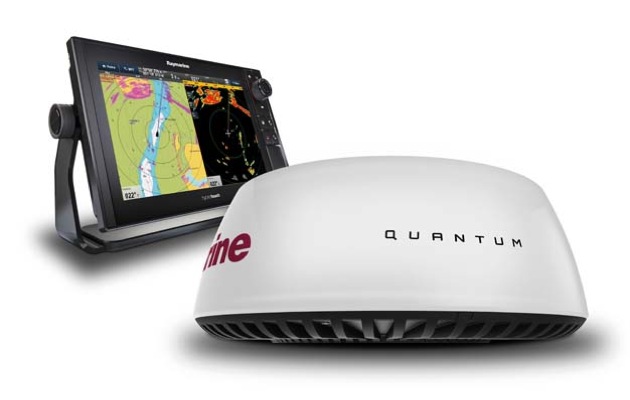This exciting new radar from Raymarine offers sharper, more defined images in a lighter, more efficient package. Toby Hodges investigates
Raymarine claims its new Quantum Chirp radome is the lightest and most efficient radar in its class. Chirp technology is used increasingly by marine manufacturers in echo sounders to increase target resolution when fishfinding.
The same benefits are applied to marine radar with this, the industry’s first compact recreational radome with Chirp pulse compression technology. This produces sharper, more defined images by sending out variable frequencies simultaneously.
Raymarine’s development is arguably of more interest to sailors for its weight-saving though. The 18in Quantum weighs around 50 per cent less than traditional magnetron radars. It is also a market leader in terms of power consumption and ease of installation.
What’s in the box?
At the launch Raymarine revealed the guts inside: a new solid-state circuit board compared with the metallic innards of a magnetron radar, emphasising the weight saving. The Quantum radome weighs 5.6kg.
Although there is still a spinning part inside the radome – the circuit board itself revolves – it is the information produced to send out the radar pulse that has changed.
The promised range at both ends of the scale is another benefit of this technology. The Quantum can reveal echoes from just 18ft up to 24nm away. “It has much better close-range resolution, but without the worry of big bang echoes,” says Raymarine’s head of corporate marketing, Fiona Pankhurst.
Why it makes sense
Integrated wi-fi allows Raymarine’s Quantum to network directly to multifunction displays, and simplifies installation by eliminating the need for additional radar cabling. The cable through the mast is just 7mm in diameter.
Quantum also benefits from safe emissions and minimal warm-up time like broadband radome types. Pankhurst says the benefit over these radars is that the Chirp model won’t suffer any interference from magnetron radar echoes.
Modern broadband-type radars have a reputation for not being as reliable at picking up weather and squalls than magnetron radars, owing to their lower power output – magnetron types have a far larger peak output. Raymarine insists this is something it has addressed with the Quantum.

A look inside the case. Note the solid state circuit board (top right, yellow) instead of metallic parts
“It is something we spent a lot of time on,” says Raymarine’s VP of engineering Gordon Pope, “making sure we get the right pulse length – as that is something we can vary because it’s not continuous – so we can get more energy at shorter ranges, for example.”
“It’s not all about the power put out, it’s about the fidelity of the signal,” adds Raymarine’s head of product management Chris Jones. There is a ‘weather mode’, which Pope is confident will “provide the level we are used to with magnetron types”. You can turn this weather mode off if you wish.
Power consumption is a further draw, at 30 per cent less than the competition, maintains Raymarine, or just half the power of a Raymarine magnetron radar (17W transmit and 7W standby). This could encourage users to keep their radar on for longer periods without worrying about needing to turn on an engine or genset.
The size of the radome is still very similar to past models, hence its installation footprint and price remain the same.
Price £1,495. www.raymarine.com




